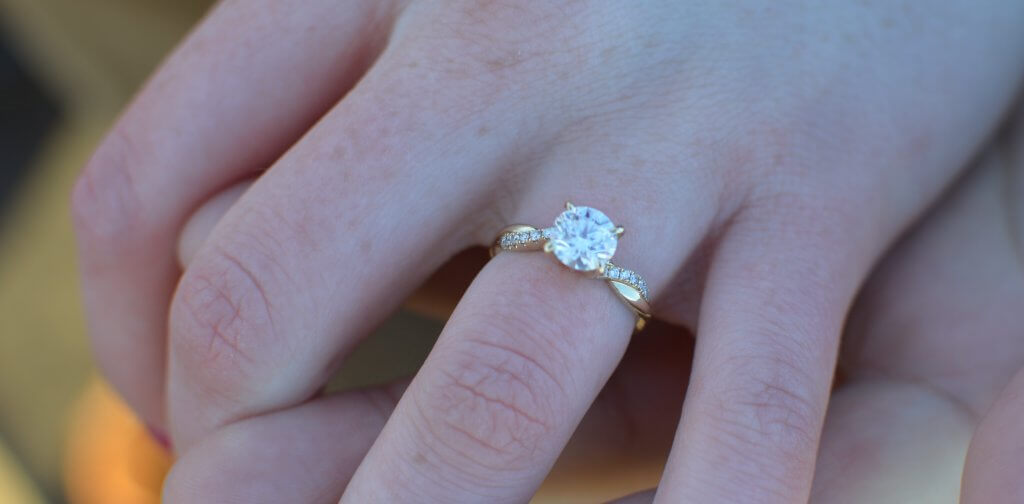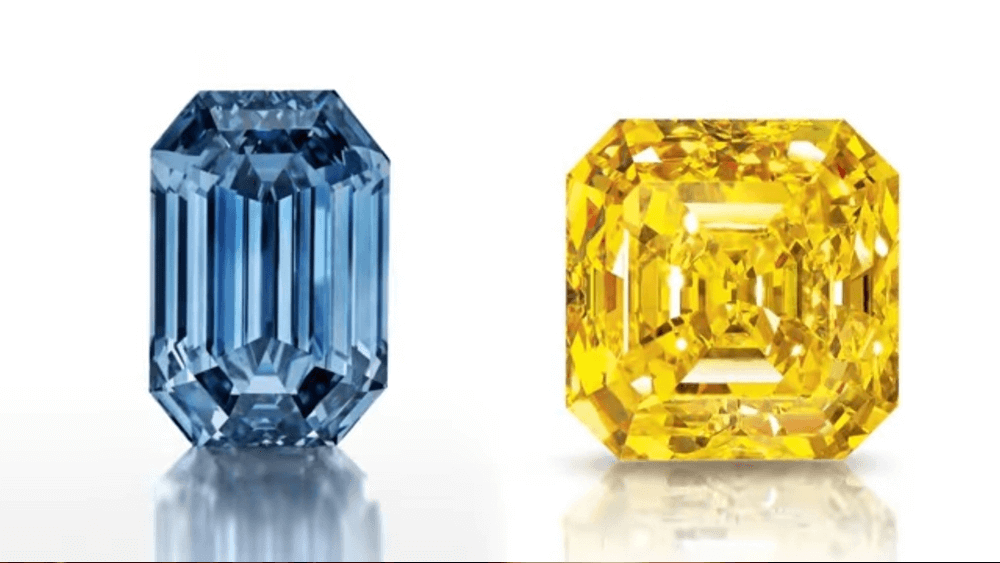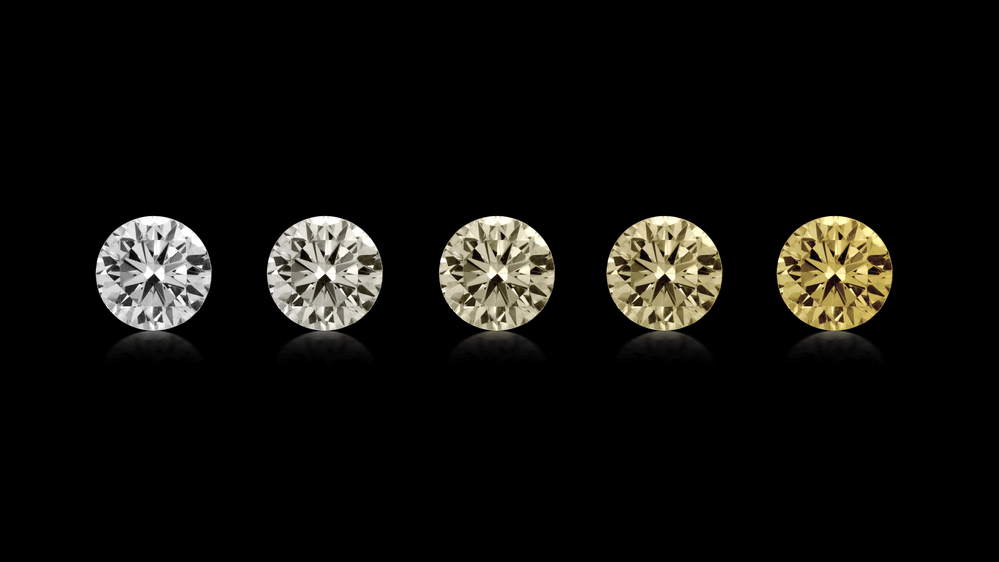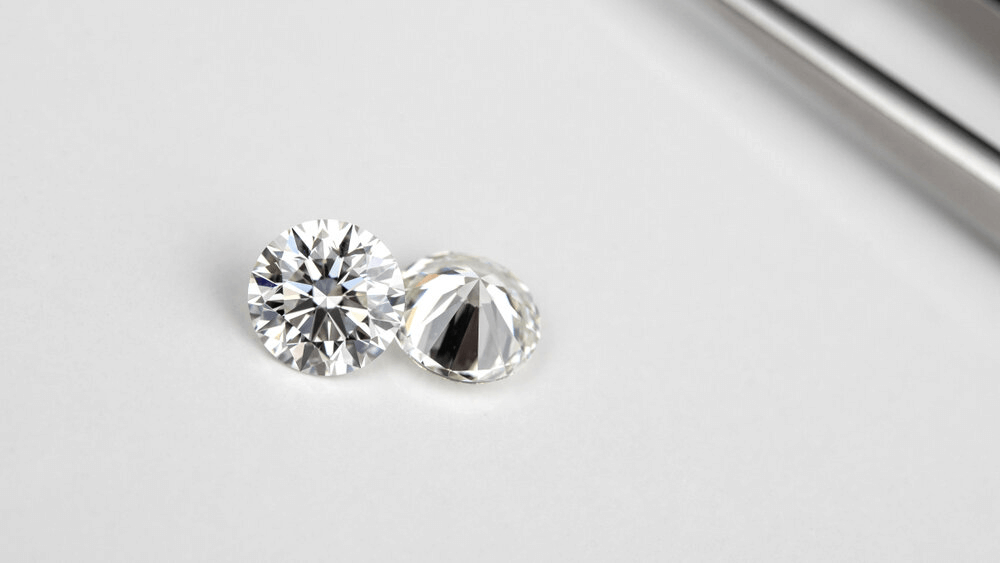Everything You Need to Know About E Color Diamonds

By Gary A.

Edited by Olivia H.
Published Sep 9, 2021
Edited on Dec 17, 2024
When it comes to achieving a perfect balance of brilliance and rarity, an E color diamond stands out as one of the finest choices for those seeking a stunning, near-flawless engagement ring.

Navigate This Guide:
- 7 Quick Tips for Examining E-Color Diamonds in Engagement Rings
- Introduction to the E Color Diamond
- D vs E-Color Diamonds
- E vs F-Color Diamonds
- E vs G-Color Diamonds
- Price Dynamics of E Grade Diamonds
- Clarity Grades and Their Impact
- Our Expert Take
- 10 FAQs
Before we dive deeper into the specifics, here are some practical tips to help guide your decision-making process:
7 Quick Tips for Examining E-Color Diamonds in Engagement Rings
When purchasing an engagement ring, especially with an E-color diamond, certain aspects need careful consideration to ensure you’re making an informed decision. Here are key tips to help you examine and choose the best E-color diamond for your engagement ring:
- Tip 1: Understand the Color Grading Scale: Familiarize yourself with the GIA color grading scale, where E-color diamonds are categorized as ‘colorless’. Knowing where E-color diamonds stand in comparison to other grades helps in making a comparative choice.
- Tip 2: Inspect Under Different Lighting Conditions: View the diamond under various lighting conditions. E-color diamonds should maintain their colorless appearance in most lighting. Notice how the diamond reacts to light – it should reflect a bright, clear sparkle without any noticeable color.
- Tip 3: Consider the Metal of the Ring Setting: The choice of metal for your ring setting can influence the appearance of the E-color diamond. Opt for white gold or platinum, as these metals enhance the colorless nature of E-color diamonds, making them appear even more brilliant.
- Tip 4: Compare with Nearby Color Grades: If possible, compare E-color diamonds side-by-side with other color grades (like D, F, or G). This comparison helps you understand the subtle differences and decide if the price difference between the grades is justified for you. Comparing diamonds should be on a folded white paper, while the diamonds are placed on the table so that the view is from the side.
- Tip 5: Check for Fluorescence: Examine the diamond for fluorescence. While not always a drawback, strong fluorescence can sometimes cause a diamond to appear hazy. E-color diamonds with no or faint fluorescence are typically more desirable.
- Tip 6: Pay Attention to Cut Quality: The cut quality of the diamond significantly affects its appearance. Ensure the diamond has a high-cut grade, as a well-cut E-color diamond will exhibit exceptional brilliance and fire, maximizing its colorless appearance.
- Tip 7: Assess the Diamond’s Clarity: Although E-color diamonds are high in the color grade, clarity still plays a crucial role. Look for diamonds where inclusions are not visible to the naked eye. A higher clarity grade, like VS1 or VS2, often pairs well with the E-color grade.
Now that you’ve got these practical tips, use Jeweler AI below to find the perfect engagement ring that suits your style and budget:
Introduction to the E Color Diamond
Finding a clear, icy diamond should be at the top of any budding diamond buyer’s list. Like any of the Four Cs, color is one of the most potentially divisive factors, and influential enough to turn an otherwise beautiful, clear, and sparkling diamond into something 99% of shoppers won’t look twice at.
This is why the GIA first introduced the Color Scale, way back in the 1940s. Instead of staring into diamonds for hours on end, talking yourself into seeing yellow behind every facet, you can use the stone’s color grade as a good indicator of how clear (or how discolored) it is and will look when worn on the finger.
Nevertheless, you’ve got to understand it first – and what better place to start than right up near the very top with E diamonds?
What Sets E Color Diamonds Apart?
An E-Color diamond has been graded according to the GIA’s rigorous standards for diamond color, and determined to be part of the sought-after category of ‘Colorless’ diamonds.
While it may sound confusing at first, the GIA Color Scale begins at D and works its way down to Z from there. As such, a D color diamond is the best you can get – free from any discernible color, even when viewed under ideal lighting and magnification. As a result, these diamonds are incredibly rare – and, accordingly, highly valuable.
E is, of course, the second highest grade on the scale, and refers to another rare group of diamonds with only marginally more color than D diamonds. So marginal that even an expert diamond grader would need ideal lighting and strong magnification to identify it.
The Visual Appeal of E Color Diamonds
E-color diamonds are clear and bright and free from even the vaguest tint of yellow or brown to the naked eye.
In other words, an E-color diamond looks like a D color diamond. As we said above, any attempt to tell the difference between the two without the right equipment would be nothing more than a guessing game, since the difference between the two grades is so minor.
This is why D and E grades – and, of course, the F-color grade – all fall into the same category: Colorless.
This can be a little confusing since, if all three are colorless, it would be simpler to give them all the same grade. This is true for casual shoppers looking for diamonds to place in jewelry but, for avid collectors, even that barely tangible difference between an E diamond and a D diamond can be cause enough to spend thousands of dollars more.
If you want to be confused even further, then consider this: while, to the naked eye, E-color diamonds look like D color diamonds, they also look like diamonds even further down the color scale, too. True, some gemologists will spot the difference way before non-experts can but, in all likelihood, your future bride is not a gemologist.
The Rarity of E Grade Diamonds
E-color diamonds are very rare – and this is one of the reasons why they are so popular among collectors. The average first-time buyer looking for an engagement ring? Not so much.
The likelihood of a natural diamond forming under the formidable conditions found so many miles beneath the earth’s surface is very, very slim. This is the same reason why Flawless diamonds are so rare – it is all too easy for other substances to get caught within the developing diamond, and to interfere with that stone’s natural beauty.
It’s much more common for diamonds to be included and colored than it is for them to be perfect, although in many cases these flaws are only visible under magnification.
D vs. E Color Diamonds
Only an expert will be able to tell the difference between D and E diamonds, and only ever with magnification and ideal lighting conditions only replicable in the lab. Neither of these diamonds represents a strong investment for an engagement ring, particularly if you’re opting for a yellow or rose gold setting.
E vs F Color Diamonds
F is also one of the colorless grades, meaning that, to the naked eye, there is no discernible difference between E and F diamonds.
That’s not to say that E diamonds represent better investments than F diamonds. Unless you’re a collector, then the difference between any of these grades is pretty meaningless – it’s a difference that is recorded on paper, within the diamond’s GIA Report, but not one that will have an impact on the overall appearance of your engagement ring.
If it’s a question of E vs F then, unless your budget has no end, we would always encourage you to focus on F-color diamonds and invest more of your budget into the rest of the Four Cs. Nevertheless, this argument can hold true even further down the color scale, so don’t settle on F-color diamonds just yet…
E vs G Color Diamonds
Chances are you won’t be able to tell any difference between E and G diamonds unless you’re a skilled and experienced gemologist or jeweler.
G color diamonds represent the fourth color grade and the first of the category termed ‘Near Colorless’ by the GIA. This means that they hold a pretty strong position, being as close to colorless as possible without the high price tag given to diamonds that are considered to be Colorless.
Take a look at this E-color 1 Carat VS2 Round Diamond, then compare it with this G color 1.37 carat VS2 Round Diamond. Can’t spot any difference between the two? That’s because, for the most part, the differences are far too minor to detect without proper lighting and magnification, meaning that both diamonds will look equally beautiful in jewelry.
What does that mean for you? Money saved – potentially thousands of dollars – simply by switching from the Colorless grades to the Near Colorless grades.
Price Dynamics of E Grade Diamonds
For an E-color grade, you can expect to pay anywhere from around $2,000 (if the diamond is particularly small or otherwise poor quality) to $20,000.
A diamond’s value is determined by its quality – color, of course, as well as clarity and cut – and, of course, its size, with the value of equally high-quality diamonds increasing exponentially with carat weight.
If you had your sights set on, say, a 4-carat diamond that checks all the boxes in terms of color, cut and clarity, then you would have to be prepared to pay a major premium – well into the five-figure range.
If, however, you were looking at an E-color diamond with significant, visible inclusions, a poor cut, or a carat weight below one, then the price would be thousands of dollars lower – although, as we’ll explain below, any reputable jeweler would likely try to talk you out of that purchase.
Suffice it to say for now that diamond color is not everything, and that there are certain factors you should be investing more of your budget into than color.

Clarity Grades and Their Impact
There’s nothing wrong with picking an E-color diamond if you can afford it, but not if it means sacrificing clarity. Since you can afford to go further down the color scale without losing any of the diamond’s beauty, we’d recommend looking at a Nearly Colorless diamond with a VS1 or VS2 clarity grade instead.
That said, We’re proponents of SI1 diamonds, provided you can find one that appears eye clean. It can, however, be much harder to find larger diamonds without visible inclusions at this clarity grade, which is why some shoppers should aim a little higher and target VS diamonds.
Our Expert Take
E grade diamonds are among the most coveted specimens in the world. But do you want a ‘specimen’ for your engagement ring or just a beautiful stone that looks perfect until it’s scrutinized under the magnifying glass?
Yes, we get it, there’s something pretty seductive about a diamond that is verging on perfect. The E-color grade, if you can get your hands on it, definitely commands a certain amount of prestige, even if you can’t always see it for yourself.
Then again, most shoppers really can’t afford to invest in an E-color diamond. Yes, you might be able to find one within your budget, but what will you have to sacrifice? If the answer to that question is clarity, cut or carat weight, then you can’t afford to invest in an E-color diamond.
Fortunately, this is no big deal. As we mentioned above, plenty of color grades that sit below E on the scale will appear almost (if not totally) identical to an E diamond, while costing thousands of dollars less. In this way, you don’t need to sacrifice the most important aspect: the diamond’s overall beauty.
10 FAQs
- Q: What is an E-Color Diamond?
- A: An E-color diamond is a high-grade, colorless diamond, second only to D in the color grading scale. It appears icy white and is almost indistinguishable from a D grade to the naked eye.
- Q: How does an E-color diamond differ from a D color diamond?
- A: The difference between D and E-color diamonds is minimal and barely perceptible. E-color diamonds have a very slight color tint, which is not visible when set in jewelry.
- Q: Is an E-color diamond a good investment?
- A: Yes, E-color diamonds are a good investment. They offer a balance of exceptional quality and value, retaining their worth well over time.
- Q: What are the best settings for E-color diamonds?
- A: E-color diamonds look stunning in white metal settings like platinum or white gold, which enhance their colorless appearance. They are versatile enough for various setting styles, including solitaire and halo.
- Q: Can you tell the difference between an E and F-color diamond?
- A: To the untrained eye, distinguishing between an E and F-color diamond is quite challenging. The difference is subtle and often requires gemological expertise to identify.
- Q: What clarity grade pairs well with an E-color diamond?
- A: Clarity grades of VS1, VS2, or VVS2 pair well with E-color diamonds, offering a good balance of clarity and color while minimizing visible inclusions.
- Q: Are E-color diamonds more expensive than lower color grades?
- A: Yes, E-color diamonds are generally more expensive than lower color grades due to their rarity and high demand. However, they are slightly less costly than D grade diamonds, making them a cost-effective option for near-perfect colorlessness.
- Q: How do I choose the right E-color diamond?
- A: Focus on the diamond’s cut quality, clarity, and certification. Compare different stones, consider your setting choice, and ensure the diamond comes with a reputable certification like GIA or AGS.
- Q: Do E-color diamonds look good in yellow gold settings?
- A: While E-color diamonds are versatile, setting them in yellow gold may slightly affect their colorless appearance. White metals like platinum or white gold are generally preferred to maintain their icy look.
- Q: Should I prioritize color or clarity when choosing a diamond?
- A: It depends on personal preference. If colorlessness is crucial for you, prioritize-color. However, a balanced approach considering both color and clarity typically results in a more visually appealing and valuable diamond.
Unlock the beauty of E color diamonds with Jeweler AI. Experience personalized, expert guidance in selecting the perfect engagement ring!
FOLLOW-UP GUIDE SERIES












